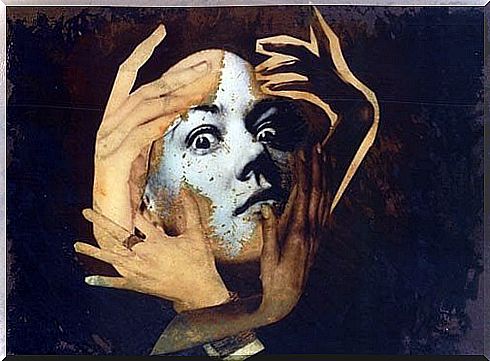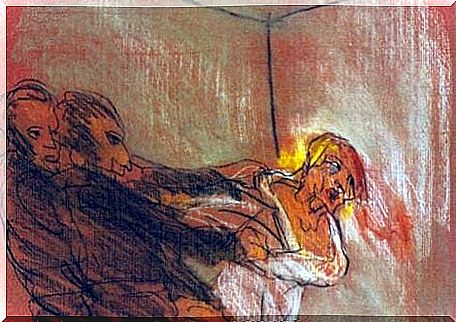Do You Know What A Delirium Really Is?
During the seventeenth century, the concept of madness relied mainly on delusions more than anything else. So “being crazy” was equivalent to “being delusional” and vice versa. Today, when we ask someone to describe what his idea of a “crazy” is, he might say someone who thinks he is Napoleon or who claims he is being chased by Martians. But those people are actually delirium.
In other words, we now have a broader view of mental problems. Yet delirium remains part of the stereotype. It is also still one of the diagnostic criteria that attracts the most attention. Etymologically, the word delirium is derived from the Latin term ‘delirare’. This word means to leave the fur that has already been cut away. When we apply this to thinking, it means something like ‘thinking outside the normal rhythm’.
In layman’s terms, a delirium means ‘to be delirious, to have a distorted way of reasoning’. But in everyday language, a delirium is almost synonymous with madness, unreasonableness or the loss of reality.
In General Psychopathology (1975), Jaspers gave the best-known definition of a delirium. According to Jaspers, delusions are misjudgments. They are very typical because the individual clings to them with great conviction. In this way they are not influenced by experiences or evidence that are irrefutable to most of us. In addition, their beliefs are often impossible.
In order to recognize a delusion, we must take into account the extent to which the experience corresponds to the following points:
- Those involved are absolutely convinced of their ideas.
- The patient also experiences these convictions as a self-evident truth and with great personal conviction.
- They will not allow their beliefs to be changed by reason or experience.
- The belief is imaginative or at least essentially improbable.
- These beliefs are not shared with other members of the social or cultural group.
- The person’s thoughts are also completely taken by this belief. He has a hard time stopping thinking or talking about it.
- The belief is a source of subjective discomfort or disrupts the person’s social functioning.
In short, the hallmark of delusions is that they are very complex conceptually. This may be why it is so difficult to determine them.

What types of delirium are there?
The classification of delusions is one of the areas researchers have worked hardest on. They have classified them according to the form they acquire and the content they have.
Types of Delusions Based on Shape
From the standpoint of form, a distinction is made in which the delusions are divided into primary or “true” delusions and the secondary delusions.
Primary Delusions
The origin of primary or true delusions is not in a previous comparable experience. By this we mean that we cannot clearly pinpoint the origin. But they are important for the following reason. Once they occur in the consciousness of the individual, it will explain much of everything that has happened to the person since the delirium started.
Often the person is disturbingly aware of the change in the meaning of their world. Everything seems different, different. This reversal also leads to terrible feelings that are difficult to describe and even harder to explain. Moreover, the explanation is incomprehensible to the average person.
It is believed that there are four types of primary delusions (Jaspers, 1975):
- Delirious intuition. A patient realizes that an acronym of his name, Emilio Albeniz de Darco, means “you are the murderer of God”, in Spanish (Eres el Asesino de Dios).
- Delirious observation. When a patient looks at how his name is written on his mailbox, for example, “realizes” that the secret police have identified him as public enemy number one.
- Exciting atmosphere. This includes the belief that the world has changed in subtle yet ominous, disturbing and difficult to describe ways.
- Delirious memory. Here the patient makes an unreasonable reconstruction of a real memory. Or the patient suddenly “remembers” something that is clearly delusional. For example, he “remembers” that he is the son of God.
Secondary Delusions
Secondary delusions are psychologically incomprehensible. They occur as a result of the patient’s attempt to explain an abnormal experience.
For example, a patient has just experienced a hallucination (he says he heard a very deep voice speak to him as if it were his father). This experience is very strange and abnormal. So there is a very good chance that someone will find with surprise that the explanation given by the patient is also strange and abnormal. He may say that this voice means, for example, that he has been chosen by God to save the world.

Types of Delusions Based on Content
The content of the delusions can also be very varied. There is a wide variety of categories in this type of classification. Here we will give an overview of the most commonly used classifications proposed by the DSM.
The delirium where people think they are being controlled
The person believes that his feelings, impulses, thoughts or actions are not his own. They are the product of a strange and irresistible force. For example, the person may feel that he is receiving directing messages through his television.
somatic delusions
This category refers to the functioning of a person’s body. For example, the patient may believe that his brain is rotten. Or a woman may be convinced that she is pregnant despite all the tests clearly showing that she is not, and so on.
envy delusions
Patients with this type of delusion are convinced that their partner is unfaithful. Yet there is no evidence of such behavior.
Delusions of greatness
These delusions involve an exaggerated assessment of personal importance, power, knowledge, or identity. It can be of a religious, physical or other nature. For example, an individual may believe that he is Napoleon Bonaparte.
poor people
The person believes that he has or will lose all of his material possessions or almost all of them.
unreasonable references
In this case, a person believes that events, objects, or people close to them have a specific and unusual meaning. Usually is also negative and unfavorable. For example, a woman may be convinced that radio programs are aimed at her.
Excessive Delusions
This is about an erroneous belief, the content of which is clearly absurd and which has no basis in any real possibility. For example, one man believes that when he had his tonsils removed as a child, a device was inserted into his head that allows him to hear the president’s voice.

Nihilistic delusions or Cotard’s syndrome
This has to do with the existence of one’s own self, of others and of the world. Let’s give some examples: “the world is over,” “I’ll never have a brain again,” or “I don’t need to eat because I’m empty.”
persecution delusions
The central theme of these delusions is that the person feels attacked, intimidated, cheated or persecuted or that he is the victim of a conspiracy. For example, a patient may believe that he is being hunted by the FBI.
Delusions of guilt
The patient feels responsible for all kinds of misery. For example, he strongly believes that he is responsible for world hunger.
Capgras syndrome
The patient believes that important people in his life have been taken over by an impostor, even though they look the same as ever.
Erotomania or Clerembault’s syndrome
The patient is convinced that someone is madly in love with him. For example, a person may very much believe that the prince of Spain is in love with her.
Some interesting cases of delusions
The subject of delusions is quite spectacular and infamous. Because they are so striking in nature, they often do not go unnoticed. So some cases have become national news. Here we give you some examples:
The case of “little Nicolas”
Young Francisco Nicolas Gomez Iglesias is on parole after posing as a counselor to the government and the National Intelligence Service of Spain (NIC). He uses false documents for this. Pursuant to Madrid’s instruction number 24, the judge ordered a forensic medical report. This states that the patient possesses a “flowery delusion of greatness”.
The assassination attempt on Ronald Reagan
Some believe that the attempt by John Hinckley Jr. to kill Ronald Reagan was a result of an erotomaniac delusion or delusion about love. Hinckley was convinced that the president’s death would cause actress Jodie Foster to publicly declare her love for him.
The film world also reflects delusions. We see this as a theme in many movies. Here are two examples:
Take Shelter (2011)
In this film, a normal father begins to give in to the fear of a possible apocalypse without any reasonable explanation.

The Witch (2015)
This film tells the life of a North American family of settlers who move to an isolated settlement in the forest. They want to start a new life there. The clash between the presence of a witch near the settlement and the family’s strict religious beliefs gradually leads to delusions.
As we have seen throughout this article, delirium is a complex mental construct. It can have several similar characteristics. On the other hand, delusions show the creative power of our mind and its need to provide coherence to the reality it perceives. Many delusions are the most plausible explanations a person finds for their hallucinations.
Bibliography
Belloch, A., Sandín, B. y Ramos, F. (Eds.) (2008). Manual of Psychopathology (2 vols.), revised edition. Madrid. McGraw Hill.
American Psychiatric Association (2014). DSM-5. Diagnostic and Statistical Manual of Mental Disorders. Editorial Medica Panamericana.









